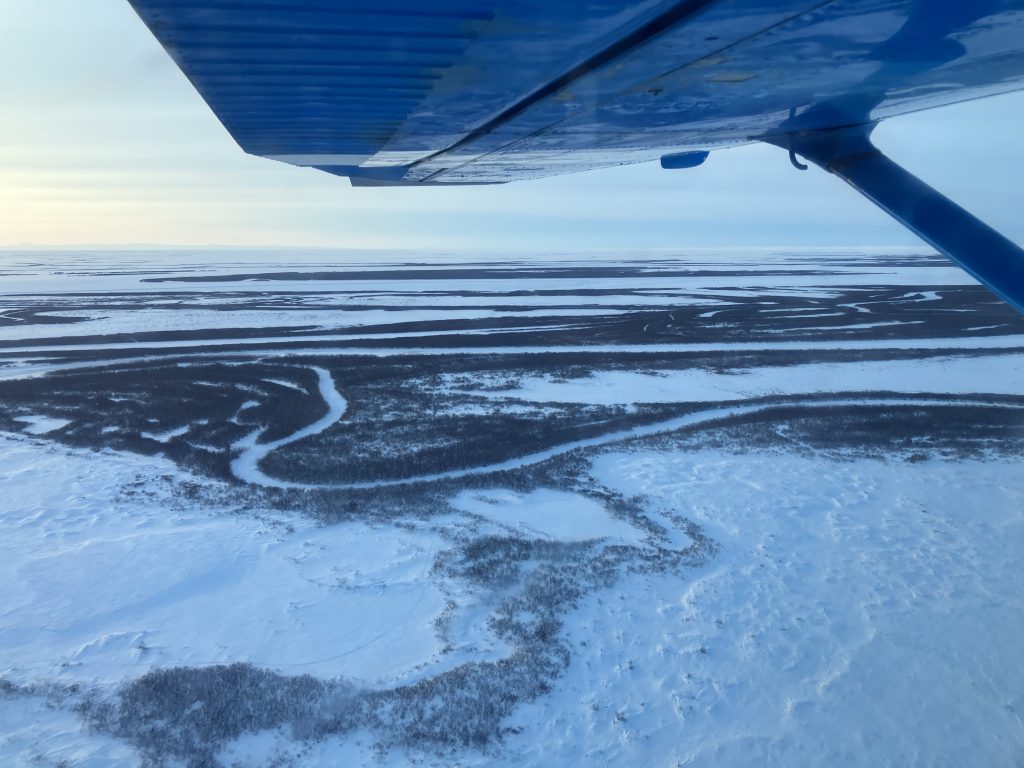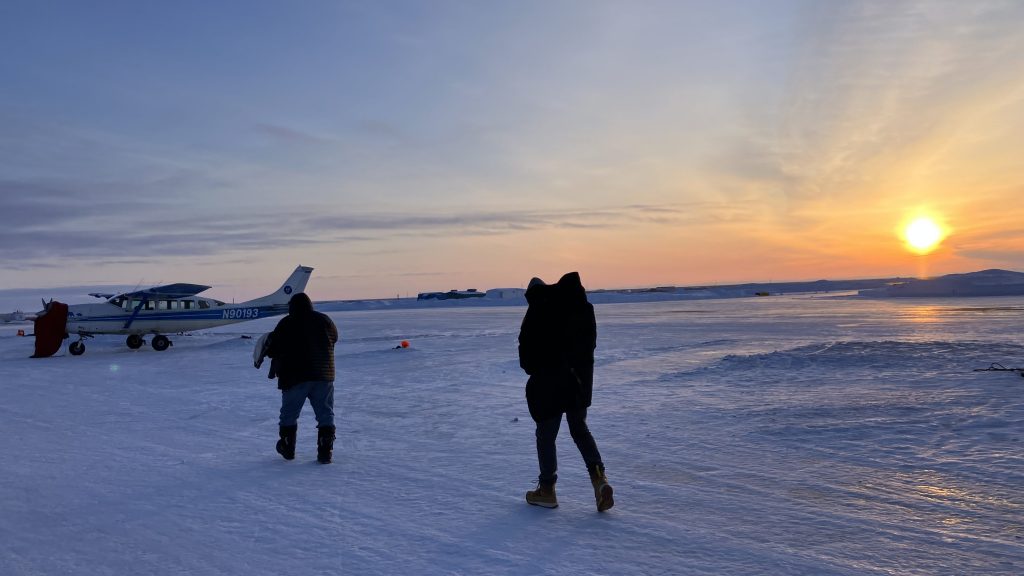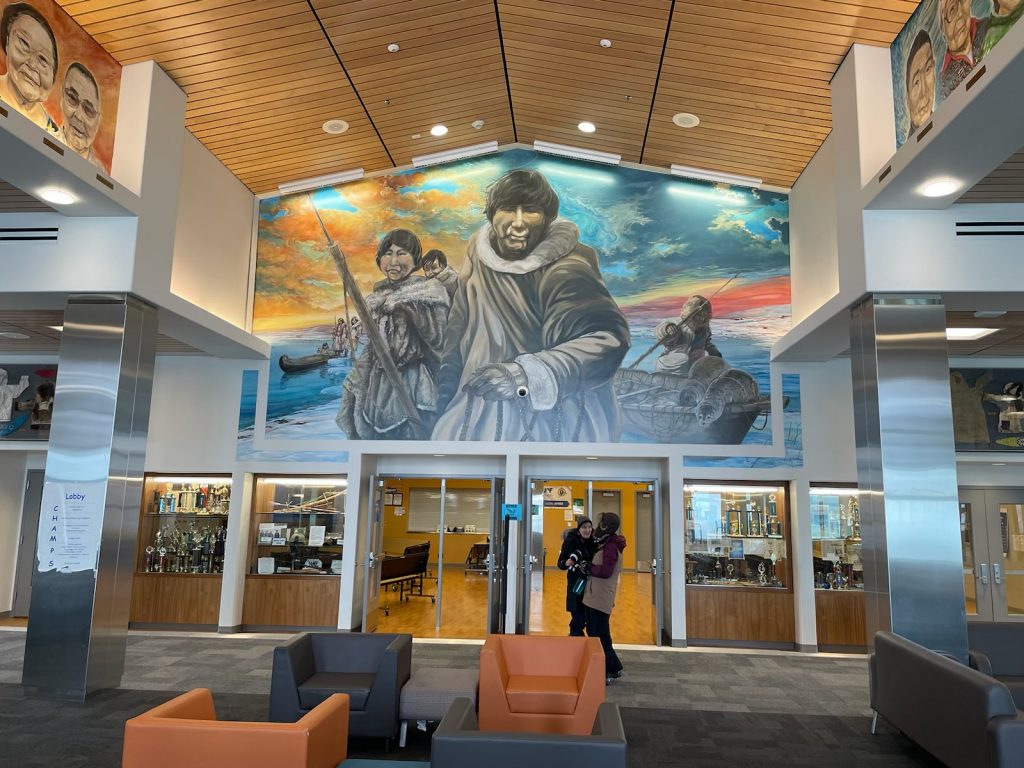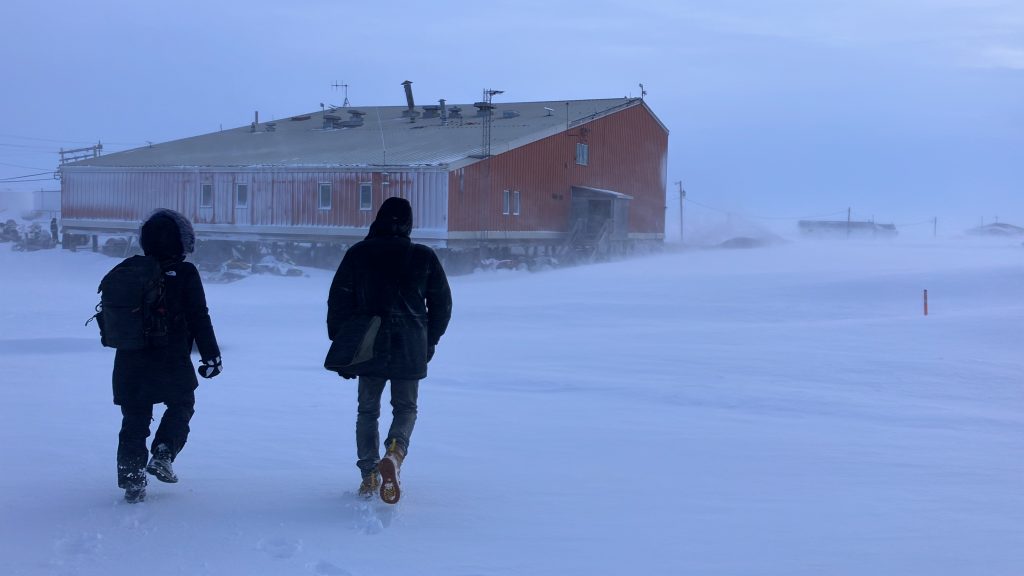This is a first-hand account of CDR Associates’ visit to the Alaska Native Village of Kipnuk as part of the Environmental Protection Agency’s (EPA) Community Change Grant Technical Assistance Program.
Text and photos by Audrey Clavijo, CDR Program Associate

Marveling at the Kugkaktlik River from the air.
We arrived in Kipnuk mid-morning on Monday, March 18, after a smooth ride from Bethel. As the tiny plane approached the Village of Kipnuk, we could see colorful snow-covered homes, criss-crossing tracks from a season of innumerable snowmobile trips, the wide meandering path of the frozen Kugkaktlik River, and the Chief Paul Memorial School positioned squarely in the center of the village.
This was my first time in the arctic tundra; it surprised me how barren the land seemed, how improbable that any species could live in a frozen desert of snow and ice. Jonathan and I stepped out onto the tarmac. We had no phone service and no idea which way to begin our trek in the cold. Noticing our looks of disorientation, a local man already at the airstrip offered us a ride on the back of his ATV and drove us to the Qanganaq Building. Jonathan and I thanked the kind stranger and entered the large, red structure, which sits alongside a tributary of the Kugkaktlik River and houses the Tribal offices. Inside, we met Chris, a member of the Kipnuk Environmental Team and the Kipnuk Permafrost Pathways Liaison, who took us on his snowmobile to meet the rest of the team at the Teacher Housing.
The Teacher Housing, attached to the school by boardwalk, is one of the few buildings in the village with access to running water and plumbing. The majority of Kipnuk’s teachers are seasonal, living in the Teacher Housing throughout the school year and returning home—typically to the lower 48—for the summer; this is also where we would be lodging for our one night in the village. To bathe and do laundry, some locals go to the Kipnuk “washeteria,” which offers paid showers and laundry. Others in the village use maqivik (steam baths) to bathe. The washeteria also has a water treatment system that is used to treat the water used in the facility. During the winter months, individual households must obtain water by collecting chipped ice, which they melt in large water buckets; in the warmer months, they obtain water through water catchment systems. Household sewage is collected in honey buckets and emptied in the lagoon.
Kipnuk has been requesting a piped water and sewer system for decades. Alaska Native Tribal Health Consortium (ANTHC) recently informed the Tribe that although ANTHC has the village on the schedule for installation of piped water and sewer infrastructure, it will be another five to ten years before that installation is complete.

Enjoying the sunrise from the airport. 
Traversing the village in snowmobiles.
At the Teacher Housing, we met the full Kipnuk Environmental Team—Rayna, Andrea, and Chris—and Sheryl Musgrove, the Climate Justice Director at the Alaska Institute for Justice (AIJ). After a series of zoom calls and meetings, this was the first time we had met in person. We shared snacks, verified the agenda for the one-day site visit, and discussed the general outline of the Community Change Grant (CCG) Technical Assistance Program. Afterwards, Rayna, Andrea, and Chris invited us onto their three snowmobiles to tour the village. Despite the snow and the frozen waterways, we could see how much of the town—including several large buildings, homes, fuel tanks, and other infrastructure—sat precariously close to the slope of the riverbank. They explained that each spring, the melting of the river ice, called “breakup,” removes large chunks of the riverbank, exacerbating the gradual erosion caused by constant currents, daily tides, and frequent storms. We passed by the barge landing, where Conex containers act as a staging area, storing equipment, construction materials, shipped goods, and hazardous waste. We then visited one of five local grocery stores, the mechanical shop (responsible for fixing just about anything that breaks down in Kipnuk), the washeteria, the landfill, the reservoir, and the Chief Paul Memorial School.
At the school, we met with the high school students—about 50 youth—to give a short presentation on the EPA, local impacts of climate change (i.e., permafrost thaw, subsidence, flooding, increasing sea level), the Community Change Grant, and our plans to apply for funding to mediate river erosion in Kipnuk. When we asked the students what they would do with the CCG funding to help their community, one advocated for the installation of running water and plumbing. Another group of girls mentioned relocating the village, a solution which several nearby villages have already turned to.
Despite their young age, it was clear the youth of Kipnuk are fully aware of the risks and challenges that currently face their community and will continue to worsen in the future. These students exude respect, resiliency, and awareness—not only for their culture, language, lifeways, and elders, but also for us as strangers and the information we shared. Furthermore, the school itself was beautiful, featuring walls covered in colorful portraits of Kipnuk’s elders and glass displays of Yup’ik art, regalia, and traditional fishing and hunting tools. Our time at the school was my personal highlight of our time in Kipnuk.

Murals and displays at the Chief Paul Memorial School. 
Audrey and Jonathan with the Kipnuk Environmental Team and Sheryl from AIJ.
After our presentation to the students, a few of us went to visit a Kipnuk elder and Tribal Council member, Peter, who was unable to attend the in-person meeting the subsequent day. He and his wife, Liz, were incredibly gracious and hospitable, welcoming us into their home. Peter told us a bit about himself, his large family of children and grandchildren (whose photos cover the walls), and his time in the US military. Liz invited us to eat and fed us stew with seal oil, dried halibut, and white fish, and frozen salmon berries harvested the past summer. While we ate, she showed us the traditional art she’d been working on: a beautiful woven seagrass basket with ornate bird designs, a fuzzy seal and beaver fur hat, and a roll of dried seal intestine to be made into a traditional Yup’ik rain jacket. As we admired her incredible work, I could not ignore the water stains on the walls, evidence of extreme flooding and water damage left by Typhoon Merbok in November 2022. Since then, the Tribe and AIJ have been working tirelessly to file paperwork and fulfill other requirements to access FEMA’s disaster relief funding to repair homes and other infrastructure destroyed by Merbok. Complicated documentation requirements and a lack of translation services, however, have made this a slow process at best and, at worst, an impassable barrier for elders in the community who speak only Yup’ik.
Outside, the wind was howling and the blizzard made it impossible to see through the windows. A young man, presumably one of Liz and Peter’s grandsons, entered the kitchen bundled in snow gear and said he was going out to chop firewood. With full stomachs and happy hearts, we thanked our gracious hosts and braved the blizzard to return to the Teacher Housing for the night. We passed a couple holding hands as they enjoyed a walk, and we saw Chris’ son wrestling in the snow with a village pup. Although the storm made it difficult to see, we pushed forward against the wind and made our way in a straight line to where we knew the school stood.
Once back in the warmth and comfort of the apartment, I thought of our arrival only a few hours earlier. I reflected on my first impression of the landscape: how improbable it seemed for people to live in such a cold, deserted place. From just a few hours with Rayna, Andrea, and Chris, the students and teachers, and the various friendly and hospitable community members we had met, it was clear to me that it takes a certain kind of resilience to live in the Alaskan tundra—and that the people of Kipnuk were likely the most resilient, resourceful, persistent, and kind people I had yet to meet.

Approaching the Qanganaq Building in windy conditions.
